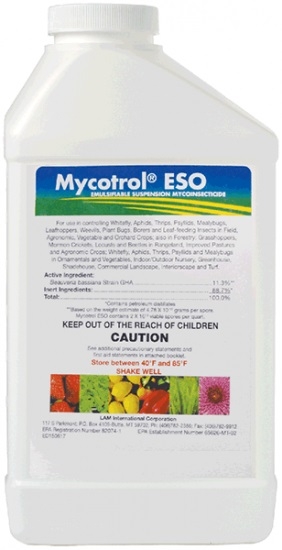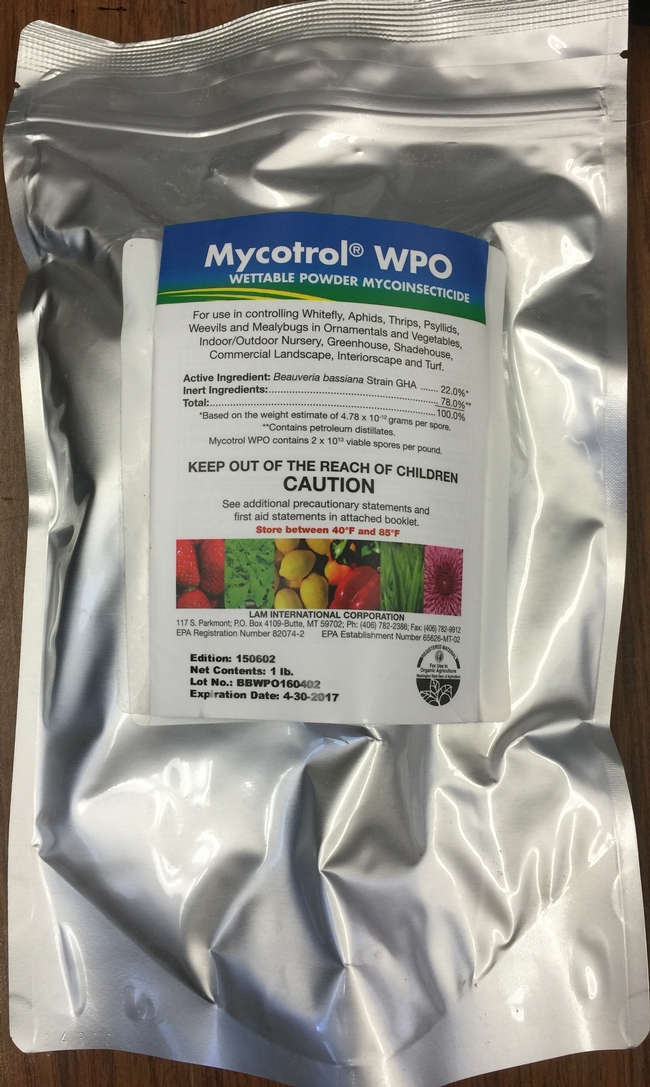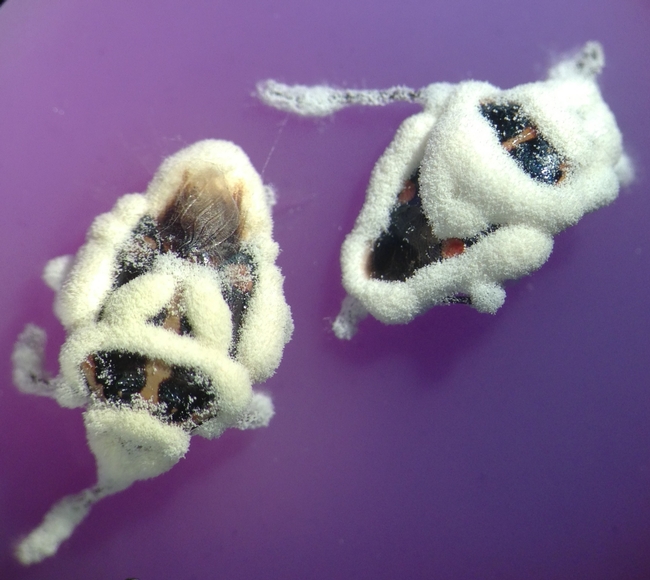Beauveria bassiana is a naturally occurring fungus that is pathogenic to several groups of arthropods. It is available in different commercial formulations for pest management in agriculture, nurseries, landscape, greenhouse, turf, and home gardens. BotaniGard ES and 22WP are the conventional formulations and Mycotrol-O was the organic-approved formulation, all distributed by BioWorks, Inc. After the OMRI organic certification for Mycotrol-O expired in August, 2015, the Butte, MT based manufacturer, LAM International, changed the formulation with an approved inert ingredient. Mycotrol ESO and Mycotrol WPO are the two new organic-approved formulations of B. bassiana registered for various pests for different situations. Both formulations have WSDA organic certifications. Unlike Mycotrol-O, ESO and WPO formulations have specific crop uses and it is important to verify labels for appropriate use.
Mycotrol ESO
It is similar to BotaniGard ES except for an organic-approved mineral oil carrier. Mycotrol ESO has a shelf life of 18 months and does not require refrigeration. However, as the product contains a live fungus, it is important to avoid exposure to high temperatures. Mycotrol ESO is registered for several agricultural crops and multiple pests except for cranberry girdler.
Mycotrol WPO
It is a formulation similar to BotaniGard 22WP except for the inert ingredients. It has a shelf life of 12 months, which is shorter than the ESO formulation, but does not require refrigeration. Avoiding storage in warmer conditions is important due to the live fungus in the formulation. Mycotrol WPO is primarily used for greenhouse, nursery, landscape, interior scape, turf, and container soil applications. Although it is registered for many agricultural crops, due to the lack of application instructions, it cannot be used on them. Unlike Mycotrol-O and ESO, WPO formulation has fewer insects on the label and is not registered for certain species of plant bugs, weevils, all stem-boring Lepidoptera, foliage-feeding Lepidoptera, and leaf-feeding beetles.
Both ESO and WPO formulations have zero preharvest interval and 4 hours of restricted entry interval. They can be tank-mixed with several other insecticides, miticides, fertilizers, and multiple fungicides. An earlier study with BotaniGard ES showed its compatibility with fungicides Merivon, Microthiol Disperss, Rally, Rovral, and Switch (Dara et al., 2014). However, Captan and Thiram were not compatible with B. bassiana.
Beauveria bassiana and other entomopathogenic fungi play an important role in IPM. Several studies showed their potential in managing strawberry and vegetable pests (Dara, 2013; 2015a, b, c, d & e). While entomopathogenic fungi can be used as standalone treatment options in several circumstances, by combining and/or rotating with chemical or botanical pesticides, they serve as an important part of the IPM tool kit for multiple crops against multiple pests.
Bagrada bugs (above) and the glassy-winged sharpshooter (below) killed by Beauveria bassiana. Fungus emerges from the insect cadaver and produces spores which can continue the infection process. (Photos by Surendra Dara)
Western tarnished plant bug (lygus bug) killed by Beauveria bassiana. (Photo by Surendra Dara)
Acknowledgment: Thanks to Daniel Peck, Bioworks, Inc. for the information on new Mycotrol formulations.
http://ucanr.edu/articlefeedback
References:
Dara, S. K. 2013. Managing aphids on broccoli and thrips on lettuce with chemical and microbial control options. March 27, 2013, UCCE eNewsletter Strawberries and Vegetables. //ucanr.edu/blogs/blogcore/postdetail.cfm?postnum=9629
Dara, S. K. 2015a. Efficacy of botanical, chemical, and microbial pesticides on twospotted spider mites and their impact on predatory mites. August 4, 2015, UCCE eNewsletter Strawberries and Vegetables. //ucanr.edu/blogs/blogcore/postdetail.cfm?postnum=18553
Dara, S. K. 2015b. Strawberry IPM 2013: managing insect pests with chemical, botanical, and microbial pesticides. October 21, 2015, UCCE eNewsletter Strawberries and Vegetables. //ucanr.edu/blogs/blogcore/postdetail.cfm?postnum=19290
Dara, S. K. 2015c. Strawberry IPM 2015: managing insect pests with chemical, botanical, microbial, and other pesticides. October 21, 2015, UCCE eNewsletter Strawberries and Vegetables. //ucanr.edu/blogs/blogcore/postdetail.cfm?postnum=19294
Dara, S. K. 2015d. Reporting the occurrence of rice root aphid and honeysuckle aphid and their management in organic celery. August 21, 2015, UCCE eNewsletter Strawberries and Vegetables. //ucanr.edu/blogs/blogcore/postdetail.cfm?postnum=18740
Dara, S. K. 2015e. Strawberry IPM 2015: managing insect pests with chemical, botanical, microbial, and mechanical control options. November 30, 2015, UCCE eNewsletter Strawberries and Vegetables. //ucanr.edu/blogs/blogcore/postdetail.cfm?postnum=19641
Dara, S.S.R., S. S. Dara, A. Sahoo, H. Bellam, and S. K. Dara. 2014. Can entomopathogenic fungus, Beauveria bassiana can be used ffor pest managmentt when fungicides are used ffor disease management? 23 October, 2014, UCCE eNewsletter Strawberries and Vegetables. //ucanr.edu/blogs/blogcore/postdetail.cfm?postnum=15671





